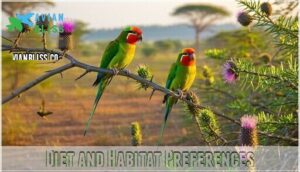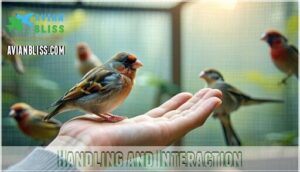This site is supported by our readers. We may earn a commission, at no cost to you, if you purchase through links.

These small songbirds range from thumb-sized Andean siskins to robust hawfinches, with lifespans reaching up to 10 years in captivity.
They’re famous for developing regional song dialects and some species can mimic human speech.
Darwin’s observations of Galápagos finches helped shape our understanding of evolution, while their specialized beaks perfectly match their preferred foods.
From their role as historical canaries in coal mines to their popularity as pets, finches continue surprising scientists with their complex social behaviors and remarkable adaptability.
Table Of Contents
- Key Takeaways
- Finch Family and Species Facts
- Physical Characteristics and Size
- Behavioral Traits and Singing Abilities
- Diet and Habitat Preferences
- Finch as Pets
- Unique Facts About Finches
- Finch Classification Debate
- Social Behavior and Companionship
- Handling and Interaction
- Physical Characteristics and Housing
- Frequently Asked Questions (FAQs)
- What’s special about finches?
- Do finches recognize people?
- What is the mythology of the finch bird?
- What is the debate surrounding the classification of finches as softbills or hardbills?
- How do finches interact with other bird species in their habitat?
- Can finches be kept as pets and what are their specific care requirements?
- What diseases commonly affect pet finches?
- How do finches navigate during migration?
- What predators threaten wild finch populations?
- How do finches communicate with chicks?
- Conclusion
Key Takeaways
- You’ll find over 650 finch species worldwide – These remarkable birds span four distinct families and showcase incredible diversity, from tiny 3-inch Andean Siskins to robust 10-inch Pine Grosbeaks, each adapted to unique environments from arctic tundra to tropical rainforests.
- Finches develop regional song dialects and some can mimic human speech – You’ll discover that these birds create cryptic dialects detectable only by AI, while bullfinches can master complex human melodies with remarkable precision, proving they’re nature’s understated musical virtuosos.
- Darwin’s finch observations shaped our understanding of evolution – You’ll see how these Galápagos birds demonstrated adaptive radiation through specialized beak shapes, with each species perfectly matched to their food sources, providing crucial evidence for natural selection theory.
- Finches require companionship and can’t thrive alone – You’ll need to house them in pairs or small flocks since isolation causes serious health problems, stress-related illnesses, and reduced lifespans, as these social birds prefer observing humans from a distance rather than direct handling.
Finch Family and Species Facts
You’ll discover four distinct finch families containing over 650 species worldwide, with true finches belonging to the Fringillidae family.
Scientists recognize these "true finches" by their small conical beaks, long tails, and the males’ brighter plumage used for attracting mates.
Number of Finch Families
You’ll find four distinct finch families in the bird world, each with unique family characteristics.
The Fringillidae family leads with 230 species, showcasing remarkable finch evolution through genetic lineages and taxonomic clusters that help with finch identification.
Here are the main finch families:
- Fringillidae – True finches with 230 species
- Estrildidae – Waxbills with 130+ species
- Ploceidae – Weavers with 150+ species
- Passeridae – Sparrows with 30+ species.
These finch bird facts reveal how types of finches developed distinct traits over time.
Varieties of Finch Species
The finch world showcases remarkable diversity with over 650 species across four families.
You’ll discover fascinating varieties through their unique characteristics:
- Darwins finches evolved distinct beak shapes on the Galapagos islands
- Finch hybrids create new combinations between related species
- Geographic variation produces different traits across regions
- Rare finches include endangered species like the Mangrove Finch
- Types of finches range from colorful Gouldians to hardy House Finches
Distinction of True Finches
True finches belong to the Fringillidae family, which scientists call the "real deal" among finch bird species.
You’ll recognize these finch birds by their conical beaks, perfect for cracking seeds.
Male plumage typically outshines females with brighter colors during breeding season.
Canary relation to this family surprises many people – they’re actually true finches too.
These seed eaters have evolved specialized traits that separate them from other finch bird taxonomy groups.
Physical Characteristics and Size
When you look at finches, you’ll find they come in a remarkable size range from just 3 inches to 10 inches long.
The smallest species like the Andean Siskin barely reach 4 inches, while giants like the Pine Grosbeak can stretch nearly 10 inches from beak to tail.
Size Range of Finches
You’ll discover that finch birds showcase remarkable diversity in their body proportions and size adaptations.
These miniature finches range from 3 to 10 inches, with beak dimensions varying substantially across species.
Giant varieties like the Pine Grosbeak contrast sharply with smaller cousins.
This finch size range reflects evolutionary adaptations to different environments and food sources.
Each finch species demonstrates unique physical characteristics that make finch facts particularly fascinating for bird enthusiasts studying these remarkable creatures, with a focus on their body proportions.
Smallest and Largest Finch Species
Among finch birds, you’ll find incredible size extremes that highlight finch proportions perfectly.
The tiny Andean Siskin measures just 3.7-4.3 inches, while the massive Pine Grosbeak reaches 7.9-10 inches.
These finch species show how body mass varies dramatically within finch size ranges.
From delicate miniatures to hefty giants, finch facts reveal nature’s amazing diversity in one bird family.
Average Lifespan of Finches
Your finch bird lifespan depends on several factors affecting their health and environment.
Wild finches typically live 5-10 years, while captive lifespan can extend to 27 years with proper care.
Species variation plays a role in longevity expectations.
You’ll find extending lifespan requires good nutrition, safe housing, and veterinary care.
Finch survival is aided by their specialized beak shapes suited to their diet.
These finch facts help you understand finch bird lifespan expectations better.
Behavioral Traits and Singing Abilities
You’ll discover that finches have remarkable vocal abilities that vary greatly between species.
From chaffinches that develop regional accents to bullfinches that can mimic human melodies, these birds showcase complex communication skills that scientists are still studying today.
Regional Accents in Finch Songs
Beyond size variations, finch bird song reveals remarkable regional differences.
Scientists have discovered that zebra finches develop cryptic dialects detectable only by artificial intelligence, while Darwin’s finches maintain population-specific songs through cultural transmission.
Geographic isolation shapes these bird regional variations through:
- Song evolution across generations
- Dialect formation within local populations
- Learning influence from fathers and neighbors
- Cultural transmission during sensitive periods
- Geographic isolation creating distinct patterns
These finch bird behavior patterns show how bird songs adapt to local environments through imperfect copying and social learning.
These adaptations can be influenced by climate driven evolution, potentially leading to speciation.
Mimicking Ability of Bullfinches
Bullfinches demonstrate exceptional vocal mimicry skills, learning complex human melodies with remarkable precision.
These intelligent finch birds can master intricate tune learning through repeated exposure and practice sessions.
These brilliant birds decode complex melodies like tiny musical geniuses, proving finches are nature’s understated virtuosos.
They’re also known for their ability to imitate sounds, showcasing their extraordinary sound imitation.
- Vocal Mimicry Mastery – Bullfinches accurately reproduce folk melodies containing 20-50 notes with proper timing and pitch
- Imitation Extent – Most individuals learn up to three distinct tunes, while exceptional birds master even more complex sequences
- Bullfinch Intelligence – Their mimicry purpose involves advanced cognitive processing, demonstrating sophisticated auditory-motor integration in bird behavior
Quiet Nature of Finches
Finch birds offer surprisingly quiet companionship, making them perfect for apartment living.
Their low vocalizations create soothing sounds that won’t disturb neighbors or family members.
Unlike louder pet birds, finches maintain a gentle finch volume that provides peaceful background noise.
These quiet companions communicate through soft chirps and melodic songs rather than harsh calls.
Their quiet nature makes finches ideal pets for those seeking calm, stress-free bird ownership without noise complaints.
They provide peaceful background noise, making them a great choice for apartment living.
Unique Feeding Behavior of Some Species
You’ll discover that finches aren’t just seed eaters—they’re dining acrobats with surprising tricks.
These clever birds have developed remarkable feeding behavior that showcases their adaptability and intelligence.
- Upside-down feeding: Smaller species like Lesser Redpolls hang upside down to access hard-to-reach seeds
- Dietary adaptations: Warbler finch diet consists mainly of insects, while others crack seeds with specialized finch beaks
- Water access needs: All finches require regular water for drinking and bathing to maintain their health
Diet and Habitat Preferences
You’ll discover that finches have adapted to nearly every habitat on Earth, from tropical rainforests to arctic tundra edges.
Their diverse diets and nesting preferences reveal fascinating survival strategies that have allowed these remarkable birds to thrive across six continents.
Global Distribution of Finches
You’ll find finch birds across every continent except Antarctica, showcasing remarkable habitat adaptation.
Their continental distribution spans from North America’s House Finches thriving in urban settings to Australia’s colorful Gouldian Finches requiring specific humidity levels.
Climate influence shapes their migration patterns, with some species traveling seasonally while others remain year-round residents.
Introduced species have expanded beyond native ranges, adapting to new environments.
These adaptable birds occupy diverse habitats from temperate forests to tropical grasslands, demonstrating impressive flexibility in their global distribution across varied ecosystems and environmental conditions, including their ability to thrive in urban settings and specific humidity levels.
Finch Species in The Galapagos Islands
The Galapagos Islands house thirteen unique finch species that showcase remarkable evolutionary history through adaptive radiation.
Thirteen unique finch species evolved on the Galapagos Islands, showcasing nature’s remarkable adaptive radiation in action.
These Galapagos finches evolved from a single ancestor, developing distinct beak morphology to match available food sources across different islands.
- Beak shape variations range from thin needle-like beaks for nectar feeding to thick crushing beaks for hard seeds
- Finch adaptations include specialized feeding behaviors like using tools to extract insects from tree bark
- Conservation status varies among species, with some facing threats from human impact and habitat changes
- Finch evolution continues today as scientists observe ongoing changes in beak size based on environmental conditions
Influence on Darwin’s Natural Selection
Darwin’s groundbreaking theory emerged from studying these remarkable birds on remote islands.
Galapagos finches demonstrated adaptive radiation through dramatic beak variations perfectly suited to different food sources.
Natural selection shaped each species’ evolutionary significance as finch bird adaptations revealed how environment drives survival.
These finch evolution examples proved beak shape directly correlates with feeding success and species development.
Relationship Between Diet and Coloration
Your finch’s diet directly shapes its colorful plumage through carotenoid intake and melanin production.
These dietary pigments create stunning visual displays that reflect the bird’s health and genetic influence on color expression.
- Carotenoid intake from seeds and fruits determines red, yellow, and orange hues in finch bird plumage
- Melanin production creates darker colors and patterns based on the bird’s genetic makeup
- Plumage brightness increases when finches consume nutrient-rich sources containing specific pigments
- Diet preferences for certain foods directly influence how vibrant and attractive their colorful plumage appears
Nesting Habits of Finches
You’ll find that finches are skilled architects in the matter of building their homes.
These birds construct intricate nests using twigs, grass, and feathers in tree branches, cavities, or holes.
Finch nests vary by species – some prefer dense shrubs while others choose open woodlands, and their finch bird habitat selection depends on available nest materials and protection from predators.
Most species lay 3-5 eggs per clutch, with parents showing strong nest defense behaviors to protect their young, which is a critical aspect of their survival.
Finch as Pets
You’ll find that finches make wonderful pets when you understand their unique needs and social nature.
These small songbirds require careful consideration regarding handling, companionship, and proper housing to thrive in captivity, which is crucial for their well-being and highlights the importance of proper housing.
Handling and Interactions With Finches
Unlike most pets, finches require minimal handling to maintain their well-being.
These delicate birds experience significant handling stress when touched frequently, so you’ll want to limit physical contact to essential care only.
- Medical handling should occur only during health emergencies or routine veterinary visits
- Minimizing touch prevents anxiety and allows natural finch temperament to flourish
- Observing behavior from a distance provides better insight into your finches as pets
- Finch interaction works best through gentle voice communication rather than physical contact
Need for Companionship
With finches as pets, you’ll discover that companionship isn’t optional—it’s essential for their well-being.
These social birds thrive in pairs or small flocks, as isolation can lead to serious health and behavioral problems.
- Flock Dynamics: Finches establish social hierarchy naturally, creating bonds that reduce stress and promote healthy behaviors
- Isolation Effects: Solitary finches often develop destructive habits, loss of appetite, and weakened immune systems that compromise their health
- Vocal Communication: Paired finches engage in constant chirping exchanges, maintaining their natural communication patterns essential for mental stimulation
Suitable Finch Species for Beginners
Four hardy finches make excellent beginner pets: Zebra Finches top the list as forgiving, low maintenance companions that tolerate care mistakes gracefully.
Society Finches offer gentle temperaments and strong social needs.
Star Finches provide peaceful dispositions but need stable temperatures.
Essential finch supplies are available online.
These quiet singers thrive in pairs, making pet finches ideal for new bird owners seeking rewarding experiences.
Housing Requirements for Finches
Your finches need spacious enclosures with proper cage size of at least 30 inches wide for flight. Bar spacing should be half an inch or less to prevent escapes.
Include varied perch types at different heights for foot health. Enrichment needs like swings and toys keep finches as pets mentally stimulated.
Easy to clean birdhouses simplify upkeep. Location matters – place away from drafts and direct sunlight for ideal finch care.
Popularity of Gouldian Finches
Why are Gouldian finches so popular among bird enthusiasts?
These stunning finch birds captivate owners with their vibrant multicolored plumage and gentle temperament.
You’ll find Gouldian finches make popular pets despite breeding challenges and specific care needs.
Their striking Gouldian colors and fascinating Gouldian mutations appeal to experienced keepers, though beginner friendliness remains limited compared to other finches as pets.
Unique Facts About Finches
You’ll discover some surprising facts about finches that go beyond their beautiful songs and colorful feathers.
These remarkable birds have played roles in human history, from serving as early warning systems in dangerous mines to inspiring groundbreaking scientific theories about evolution.
Historical Role of Finches in Mines
Looking beyond pet ownership, canaries and other finch birds played a life-saving role in coal mines. These Mining Canary heroes served as Early Detection systems for toxic gases from the late 1800s through 1986.
Their high sensitivity to carbon monoxide made them perfect sentinels for Air Quality monitoring, though Ethical Concerns eventually ended this practice when electronic detectors replaced these brave bird species.
- Canaries collapsed quickly when exposed to deadly carbon monoxide gas
- British miners carried caged finches deep underground as living alarm systems
- Special oxygen-equipped cages helped revive birds after gas exposure
- Mining regulations required two small birds at each mine entrance by 1911
- Electronic sensors finally replaced these feathered guardians in the 1980s
Common Finch Species in The U.K
Britain’s countryside hosts several fascinating finch species that you’ll encounter during birdwatching adventures.
These Fringillidae family members showcase remarkable diversity in their habitat distribution and population trends across the UK.
| Common UK Finch Species | Conservation Status |
|---|---|
| Goldfinch | Stable population |
| Greenfinch | Declining numbers |
| Siskin | Increasing trend |
| Bullfinch | Protected under UK legislation |
| Chaffinch | Most abundant species |
Species identification becomes easier when you understand each finch’s unique characteristics and preferred habitats throughout Britain’s diverse landscapes.
Rarity of The Mangrove Finch
Among the world’s rarest birds, you’ll find the mangrove finch teetering on extinction’s edge. This critically endangered finch bird species faces severe population decline, with fewer than 100 individuals remaining on Isabela Island in the Galápagos Islands.
The threats they face are similar to those impacting the Cebu Flowerpecker rediscovery.
- Habitat loss threatens their mangrove forest homes
- Invasive species cause devastating nest failures
- Disease risks endanger the isolated population
- Conservation efforts include captive breeding programs
- Genetic diversity remains limited but viable
Finch as State Birds in The U.S
You’ll find only four finch species hold the honor of being state birds in America.
The American Goldfinch represents Iowa, New Jersey, and Washington, while New Hampshire chose the Purple Finch.
These selections reflect each state’s Regional Finch Popularity and careful Finch Selection Process.
State Finch Symbolism emphasizes renewal and resilience, boosting Economic Finch Impact through increased awareness and Finch Conservation Efforts for these beloved North American finches.
Finch Classification Debate
You’ll find that scientists still debate how to classify finches based on their diet and bill structure.
The aviculture community remains divided between softbill and hardbill categories, with no clear consensus on whether finches should be grouped by their seed-eating habits or their ability to process softer foods.
Controversy Over Softbill Vs. Hardbill Classification
You’ve likely wondered whether finch birds belong to the softbill or hardbill category.
The finch families—Fringillidae and Estrildidae—create ongoing Classification Accuracy debates in aviculture.
Dietary Discrepancies fuel this controversy since finches eat seeds but lack hooked beaks.
The Evolutionary Basis supports hardbill classification, yet Avicultural Impact shows mixed practices.
Taxonomic Revision remains elusive despite decades of discussion, highlighting the need for clearer Classification Accuracy.
Ongoing Debate Within Aviculture Community
Within the aviculture community, finch birds face ongoing Classification Validity disputes that divide enthusiasts and experts alike.
You’ll find heated debates over scientific classification methods, with some advocating dietbased distinctions while others reject this approach entirely.
The classification debate extends to Show Standards, where Hybridization Concerns and Ethical Breeding practices clash with Conservation Priorities.
These disagreements affect breeding programs, exhibition criteria, and species recognition across different organizations and regions worldwide.
Lack of Consensus on Diet Preferences
You’ll encounter conflicting advice about finch bird diet preferences across aviculture communities.
Some experts emphasize seed specialization while others highlight insect consumption needs.
Dietary generalizations don’t work since species vary widely in nutritional needs.
Fruit dependence matters for certain finches, complicating softbill vs hardbill classifications.
These diet-based distinctions remain contentious without clear resolution, emphasizing the need for understanding nutritional needs.
Persistent Debate Without Resolution
This classification debate continues without clear resolution despite decades of scientific research.
Bird species classification debate affects finch bird identification and conservation priorities across multiple disciplines.
The persistent controversy impacts several key areas:
- Classification Accuracy – Taxonomic revisions struggle with evolutionary relationships
- Hybridization Impact – Cross-breeding complicates bird species comparison methods
- Feeding Behavior – Diet preferences don’t align with traditional hardbill categories
- Beak Structure – Physical traits overlap between finch species classifications
- Genetic Analysis – DNA studies reveal unexpected evolutionary relationships
- Conservation Priorities – Unclear classifications affect protection strategies
- Research Funding – Disputed bird classification limits scientific investment
- Field Identification – Birders face challenges distinguishing similar bird species
Social Behavior and Companionship
If you’re curious about finch social habits, you’ll find these birds are incredibly social creatures who need companionship to thrive.
They prefer living with other finches in pairs or small flocks rather than being alone, and isolation can lead to serious health and behavioral problems.
Preference for Finch Companionship
Finch birds crave companionship from their own kind rather than humans.
These social creatures develop complex flock dynamics and species compatibility preferences.
Isolation impact causes stress and behavioral problems in pet finches.
Social hierarchy emerges naturally within groups, making enrichment needs essential for their well-being.
| Social Aspect | With Other Finches | Without Companions |
|---|---|---|
| Behavior | Active, playful singing | Withdrawn, excessive calling |
| Health | Strong immune system | Stress-related illness |
| Lifespan | 7-10 years average | Reduced by 2-3 years |
| Mental State | Alert, engaged | Anxious, depressed |
Thriving in Pairs or Small Flocks
Your finch birds need companionship to stay happy and healthy.
When you house them in pairs or small flocks, you’ll notice remarkable improvements in their well-being and natural behaviors.
Here’s how flock dynamics benefit your finches:
- Social Hierarchy – Birds establish pecking orders that reduce conflict
- Breeding Success – Pairs bond stronger with flock support nearby
- Stress Reduction – Group living lowers anxiety and fear responses
- Behavioral Enrichment – Flocks encourage natural foraging and preening
- Communication Practice – Birds develop better vocalizations through social interaction
Secondary Preference for Human Companionship
While finch birds naturally prefer their own kind, they’ll sometimes accept you as a distant companion.
Your presence provides vocal comfort and minimal interaction without the handling stress that disrupts their well-being.
Understanding finch sociability helps you respect their flock dynamics and social behavior preferences.
| Human Companionship Aspect | Finch Response |
|---|---|
| Daily presence | Observes from distance |
| Talking to birds | Responds with soft chirps |
| Hand feeding | Accepts with caution |
| Forced interaction | Creates stress and fear |
Health Issues Arising From Solitary Housing
Solitary housing creates serious health problems for your finch.
Stress-related illnesses develop when these social birds lack companionship.
Behavioral problems like feather plucking emerge from boredom and loneliness.
Social deprivation weakens their immune system, making them vulnerable to disease.
Poor finch bird care through isolation often leads to reduced lifespan and chronic stress management issues.
Enrichment through stimulating finch toys can help mitigate these serious health problems.
The importance of social birds having companionship cannot be overstated, as stress-related illnesses can have long-lasting effects.
Emotional Instability When Isolated
When you isolate finches, they experience emotional instability due to their intense social nature.
Isolation stress triggers behavioral changes that lead to health decline.
Social deprivation affects their mental well-being since flock importance runs deep in finch behavior.
Without companions, they develop anxiety-like symptoms.
Human companionship can’t replace their need for other finches completely.
Handling and Interaction
You’ll find that finches generally don’t enjoy being handled and can become stressed or frightened when you try to pick them up.
However, you may need to handle them occasionally for health checks or medical care, though they’re more likely to observe you from a distance rather than perch on your finger, which can be a frightening experience for them.
Limited Human Interaction Recommended
Unlike their social bonds with other finches, these birds don’t crave human attention.
You’ll want to observe finch behavior from a distance rather than handle them frequently. Finch stress increases with excessive touching, so minimal intervention works best.
Their quiet nature and finch autonomy mean they prefer watching you over direct interaction. Respecting finch habitat boundaries supports healthy social behavior across all finch species, and understanding their need for minimal intervention is crucial. By giving them space, you’re promoting their quiet nature.
Avoidance of Stress and Fright
When handling finches, you’ll want to recognize fright triggers that cause their flight response.
Sudden movements, loud noises, and unexpected changes create stress that affects their social behavior and emotional stability.
Use calming signals like slow movements and quiet voices.
Environmental enrichment helps reduce anxiety.
Proper handling techniques involve minimal contact and respect for their observer behavior toward humans.
Exceptions to Handling Reluctance
Some finch species become more accepting of human contact through specific circumstances.
Hand-reared birds often show reduced handling reluctance due to imprinting effects from early human interaction.
Taming methods can gradually condition certain finches to tolerate gentle contact.
Emergency situations requiring medical procedures may necessitate handling despite natural bird species behavior, which can vary substantially among different finch species and individual pet birds, due to specific circumstances and natural behavior.
Necessity for Health and Medical Care
Medical situations require careful handling despite your finch’s natural reluctance.
Disease prevention and injury treatment become necessary when health issues arise.
You’ll need veterinary access for proper bird medical care and emergency care situations.
Nutritional needs may require direct intervention for finch bird diseases.
Pet bird care includes regular health monitoring and bird health assessments when problems develop.
Proper care is essential for preventing and treating diseases, and veterinary access is crucial in emergency situations, ensuring your finch receives the best possible medical care.
Natural Observer Behavior Towards Humans
You’ll notice finches watching you from their perches with curious eyes.
Their observer behavior shows natural wariness mixed with fascination. While they rarely approach for direct interaction, finches display vocal reactions and behavioral changes when humans are present.
This social nature creates a unique bond through visual connection rather than physical handling, reducing handling stress while building finch trust.
Physical Characteristics and Housing
You’ll discover that finches come in remarkably small packages, typically measuring just 3 to 10 inches in length, yet they display an incredible array of colors and patterns that make each species unique.
These tiny birds require specialized housing that accommodates their active nature and social needs, with proper cage dimensions and bar spacing being critical for their health and safety, ensuring their active nature and social needs are met.
Small Size With Diverse Colors
Despite their compact size ranging from 3 to 10 inches, finches showcase remarkable plumage variation that makes them truly enchanting.
You’ll find these miniature species display vibrant appearances through diverse color genetics, from brilliant reds and yellows to subtle browns and grays.
Their colorful feathers serve as visual communication tools, especially during breeding season when pretty birds attract mates.
Many species owe their coloration to melanin and carotenoids, which produce a range of hues.
This size advantage allows finches to thrive in various environments while maintaining their striking beauty and charm.
Need for Sp
Housing requirements for finches go beyond basic shelter needs.
You’ll need to provide spacious enclosures that allow these active bird species to fly freely and exercise naturally.
Finch companionship thrives when you give them room for social interaction within their flock.
Your finches can’t express their natural behaviors without adequate space.
Proper housing supports flock wellbeing by reducing handling stress and accommodating their vocalization volume needs.
Consider browsing a site for suitable finch cages to find the right fit.
These bird facts show that cramped spaces lead to health problems and behavioral issues in finches.
Frequently Asked Questions (FAQs)
What’s special about finches?
Picture a tiny acrobat hanging upside-down from a thistle, cracking seeds with surgical precision.
You’ll find finches remarkable for their incredible diversity—650+ species with specialized beaks, regional song dialects, and adaptive radiation that helped Darwin understand evolution.
The diversity of finches, with their specialized beaks, is a key aspect of their biology.
Do finches recognize people?
Finches don’t really recognize individual people the way dogs or cats do.
They’re more focused on other finches and view humans as part of their environment rather than forming personal bonds with specific individuals, which can be seen as a key aspect of their behavior, particularly in how they interact.
What is the mythology of the finch bird?
Throughout mythology, you’ll find finches aren’t just birds—they’re absolute treasures of joy.
Ancient Greek tales feature finches inspiring goddess Artemis with their sweet songs, while Native American folklore celebrates them as oracles of celebration and happiness.
What is the debate surrounding the classification of finches as softbills or hardbills?
You’ll find ornithologists debating whether finches are softbills or hardbills based on their beaks.
True finches have strong, conical beaks for cracking seeds, making them hardbills, while some "finch" species eat softer foods.
How do finches interact with other bird species in their habitat?
Over 650 finch species worldwide form mixed-species flocks during non-breeding seasons, feeding alongside sparrows, buntings, and other seed-eaters.
You’ll see them competing for resources while benefiting from increased predator detection and foraging efficiency in these diverse bird communities.
Can finches be kept as pets and what are their specific care requirements?
Yes, you can keep finches as pets! They’re social birds requiring pairs or flocks, spacious flight cages, seed-based diets, and minimal handling since they prefer observing humans from afar.
What diseases commonly affect pet finches?
Common diseases you’ll encounter include respiratory infections, mites, bacterial infections, egg binding, and nutritional deficiencies.
Watch for symptoms like wheezing, feather loss, lethargy, or difficulty breathing.
Quick veterinary care prevents serious complications.
How do finches navigate during migration?
Scientists haven’t fully cracked migration’s mysteries yet, but you’ll find finches likely use celestial cues, magnetic fields, and landmarks. They’re not GPS-equipped, but their internal compass guides them remarkably well.
What predators threaten wild finch populations?
Funnily enough, the same window that lets birds watch you eat breakfast also becomes their ultimate trap.
Outdoor cats, window collisions, and pesticide use pose threats to finches, while black rats, cats, smooth-billed ani, and various insects prey on them.
How do finches communicate with chicks?
Parent finches communicate with their chicks through soft calls, feeding touches, and gentle nudges.
They use quiet chirps to signal feeding time and comfort distressed babies with soothing vocalizations that strengthen bonds.
Conclusion
Scientists estimate that roughly 30% of finch species can learn and modify their songs throughout their lives, making them exceptional among birds.
You’ve discovered that finch birds and their fascinating facts span incredible diversity, from Darwin’s groundbreaking observations to their complex social behaviors.
These remarkable songbirds continue surprising researchers with their adaptability, regional dialects, and specialized feeding habits.
Whether you’re considering them as pets or studying their evolutionary significance, finches prove that small birds can have enormous impact on our understanding of nature’s intricate designs.
- https://abcbirds.org/blog21/finch-species-united-states/
- https://www.theguardian.com/science/punctuated-equilibrium/2011/nov/02/hawaiian-honeycreepers-tangled-evolutionary-tree
- https://galapagosconservation.org.uk/wildlife/darwins-finches/
- https://www.eurekalert.org/news-releases/948090
- https://academic.oup.com/auk/article/116/3/666/5172336

















